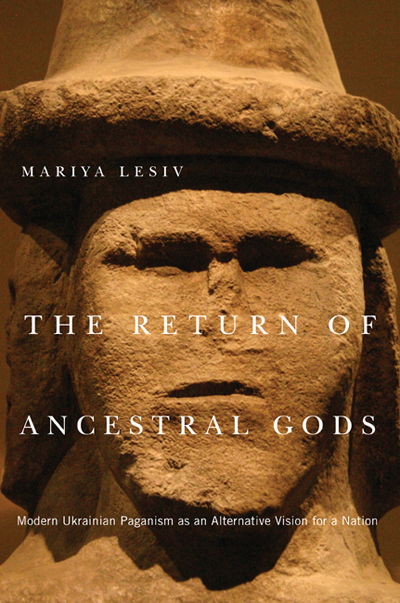Review: Return of the Ancestral Gods February 12, 2014
Author: Beach Combing | in : Actualite, Medieval, Modern , trackbackWhen this blogger thinks ‘neo-paganism’: he conjures up images of well-meaning Wiccans dancing nude in the New Forest or Californian ‘fairies’ sitting earnestly in a circle around a lonely pine and talking gnomes. But neo-paganism is not a uniform phenomenon as Mariya Lesiv’s wonderful new book, The Return of the [Ukrainian] Ancestral Gods, shows all too clearly. In this work, those of us who have had brushes with western European neo-pagans will be introduced to a new cast of heroes and villains on the banks of the Dnieper, some of whom would make a rainbow look a little monochrome.
Ukraine, as is well known, had a particularly unhappy twentieth-century history, caught between Stalin and Hitler. And, if truth be known, its previous five centuries were not particularly idyllic either: there was some dancing on the homestead but also lashings of slaughter in the woods. A country that had been so deeply traumatized had every reason for looking down into its ‘folk soul’. But when it started in search of origins it was going to come to very different conclusions from a Wiccan pioneer, who lived in a cottage in Hampshire or New Hampshire for that matter. The English Civil War or the American Civil War may have forged this or that nation’s soul but they just don’t measure up to the Ukrainian famine and associated disasters.
Neo-paganism began to emerge among Ukrainians in the decade before the Second World War when the Soviet Union was doing its best (and thankfully failing) to wipe out Ukrainian national consciousness. The Ukrainian pioneers in matters pagan, for the most part in the diaspora, were correspondingly a rather tough bunch who salted their unusual beliefs and references to long-dead or never-existing gods with forms of all too familiar east European racism. One of the many fascinating asides in The Return is the description of the impressively large Ukrainian North American neo-pagan congregation in the earlier twentieth century and it is to the credit of the author that she manages, here and elsewhere in the book, to push beyond their less savoury aspects to a spiritual core.
When you add to the race politics the fact that the sound and spelling of Ukrainian make many of the relevant deities sound-like bit-actors in an H.P.Lovecraft novella, then you have the makings of a bleak horror story. This horror story is compounded by the excessive (to western tastes) nationalism of practitioners. So when Ukrainian Neo-Pagans visited an international pagan pow-wow, one wrote afterwards: ‘in some cases, we were struck by pagan internationalism and rejection of nationalism. Americans blatantly [!! love this word] propagated tolerance, pacifism, and other ‘general human’ values’. Understandably, Ukrainian Pagans are critical of such doctrines.’ It is fair to say that political correctness has not penetrated the Ukrainian pagan movement.
The history behind the neo-pagan beliefs showcased here are, as in the west, worryingly shaky: scenery in a primary school play, rocking backwards and forwards with every round of applause from the parents. For example, Veles was an ancient Slavic god associated with cattle (see the Primary Chronicle). However, many modern neo-pagans cast him as the god of creativity and the arts. How do you get from moos to muse? Well, the Lay of Ihor’s Campaign (possibly an eighteenth-century fake) claims that a poet is Veles’ grandson. It is not much to go on. The creative reordering of spirituality is to be admired and neo-pagans do this so well: the use of pseudo-historical foundations is a little more worrying, though what religion doesn’t play fast and loose with the past?
There are moments too, many moments, indeed, of comedy in The Return, not least the ‘blatantly’ in that quotation two paragraphs above. I particularly liked ML’s photograph of the ‘Cossack Sorcerers’ – many of whom appeared singularly unconvincing as warriors – practicing Slav martial arts (?!) on the Steppes. There is also the wonderful moment in a neo-pagan Slav get-together when a Russian visitor is so exasperated by the Ukrainian conviction of supremacy that he shouts out ‘let’s sing!’: anything but talking, you understand. Then there are the sublimely described rain magic rituals. The book is never a dull read, despite its necessarily technical side-discussions.
This brings us to the author, who has written The Return very much as an academic work. In this she succeeds and the reader has a sense that they are in safe-hands as The Return progresses: McGill-Queens are to be congratulated for bringing ML’s first book out then and hopefully it will make its way quickly into paperback. But ML also has two other things going for her. First, she earns the trust of the reader early on. She is honest about her prejudices and her concerns and also, winningly, her insecurities (such as when she bluffs in a telephone call to a neo-pagan because she is not sure which national monument is being discussed). Second and crucially, she is a gifted story-teller with a saving sense of humour. Her accounts of her visits to rituals, her encounters and sometimes clashes with neo-pagans are all artfully set out: some of them could double as the better end of Sunday Newspaper journalism. You can’t often say that of academic writing…
To be recommended! Amazon link.
Any other books about neo-pagans: drbeachcombing AT yahoo DOT com I sense real potential here.



